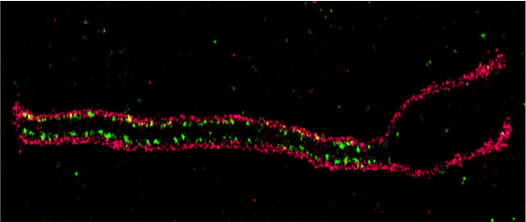Ricardo Benavente
Meiosis is a key event in the life of sexually reproductive organisms as it is the largest natural source of genetic variability

Ricardo Benavente
studied medicine at the University of the Republic (Montevideo) and received his doctorate (Dr. med.) from the University of Heidelberg. He spent his postdoctoral time as an Alexander-von-Humboldt-Fellow at the Division of Cell Biology (Head: W.W. Franke) of the German Cancer Research Center (Heidelberg). Since 1987, Ricardo Benavente leads a research group at the Biocenter of the University of Würzburg. In 1990 he habilitated (Dr. rer. nat. habil.) at the Faculty of Biology of the University of Würzburg. Since 2001, he is a member of the Latin-American Academy of Sciences. Currently, he is Extraordinary Professor and Academic Director in the Department of Cell and Developmental Biology at the Biocenter of the University of Würzburg.
benavente(at)biozentrum.uni-wuerzburg.de
Tel ++49 931 31 84254
Students Mon, 10:30 – 11:30 a.m.
Room C107
Research synopsis
Ricardo Benavente’s research interests deal with the functional organization of the cell nucleus, in particular in meiotic cells. He has been using different invertebrate and vertebrate model systems to investigate the structure, composition and dynamics of the nuclear envelope and meiotic chromosomes in both males and females. A major focus of interest has been the synaptonemal complex, an evolutionarily highly conserved chromosomal structure of meiotic cells that mediates synapsis of homologous chromosomes and is essential for proper recombination. These studies are performed with the aid of immunocytochemical, biochemical and advanced microscopical techniques which are applied to wild-type and knockout mice lacking selected meiosis-specific nuclear proteins. Currently, Ricardo Benavente studies evolutionary aspects of meiosis by investigating the properties of structural synaptonemal complex protein components across metazoans.
Selected publications
Best of PhD theses:
Zwettler, F., M.C. Spindler, S. Reinhard, T. Klein, A. Kurz, R. Benavente* & M. Sauer*: Tracking down the molecular architecture of synaptonemal complexes with expansion microscopy. Nat. Commun. 11:3222(2020).
Spindler, M.C., J. Redolfi, F. Helmprobst, P. Kollmannsberger, C. Stigloher & R. Benavente: Electron tomography of mouse LINC complexes at meiotic telomere attachment sites with and without microtubules. Commun. Biol.2: 376 (2019).
Dunce, J.M., A.E. Milburn, M. Gurusaran, I. da Cruz, L.T. Sen, R. Benavente* & O.R. Davies*: Structural basis of meiotic telomere attachment to the nuclear envelope by MAJIN-TERB2-TERB1. Nat. Commun. 9: 5355 (2018).
Schücker, K., T. Holm, C. Franke, M. Sauer & R. Benavente: Elucidation of synaptonemal complex structure by super-resolution imaging with isotropic resolution. Proc. Natl. Acad. Sci. USA 112: 2029-2033 (2015).
Fraune, J., M. Alsheimer, J.N. Volff, K. Busch, S. Fraune, T.C. Bosch & R. Benavente: Hydra meiosis reveals unexpected conservation of structural synaptonemal complex proteins across metazoans. Proc. Natl. Acad. Sci. USA 109: 16588-16593 (2012).
Schramm, S., J. Fraune, R. Naumann, A. Hernandez-Hernandez, C. Höög, H.J. Cooke, M. Alsheimer & R. Benavente: A novel mouse synaptonemal complex protein is essential for loading of central element proteins, recombination and fertility. PLoS Genet. 7: e1002088 (2011).
Methods and protocols
Schücker, K., M. Sauer & R. Benavente: Super-resolution imaging of the synaptonemal complex. Methods Cell Biol. 145: 335-346 (2018).
Spindler, M.C., F. Helmprobst, C. Stigloher & R. Benavente: EM tomography of meiotic LINC complexes. Methods Mol. Biol. 1840: 3-15 (2018).
Link, J., R. Benavente & M. Alsheimer: Analysis of meiotic telomere behavior in the mouse. Methods Mol. Biol. 1411: 195-208 (2016).
Three oldies:
Benavente, R. et al.: Inhibition of nucleolar reformation after microinjection of antibodies to RNA polymerase I into mitotic cells. J. Cell Biol. 105: 1483-1491 (1987).
Benavente, R. & G. Krohne: Involvement of nuclear lamins in postmitotic reorganization of chromatin as demonstrated by microinjection of lamin antibodies. J. Cell Biol. 103: 1847-1854 (1986).
Benavente, R., G. Krohne & W.W. Franke: Cell type-specific expression of nuclear lamina proteins during development of Xenopus laevis. Cell 41: 177-190 (1985).
Three books:
Benavente, R. & G.A. Folle (editors): Chromosomes, genomes and beyond. Máximo E. Drets dedication volume. ISBN: 978-3-8055-9492-9, 188 pp., Karger Publishers, Basel (2010).
Benavente, R. & J.N. Volff (editors): Meiosis. Book series: Genome Dynamics, vol. 5, ISBN: 978-3-8055-8967-3, 160 pp., Karger Publishers, Basel (2009). Highlighted in Human Genetics 126:475-478(2009).
Benavente, R. (editor): Molecular aspects of mouse spermatogenesis. ISBN 3-8055-7746-X, 164 pp. Karger Publishers, Basel (2004).








